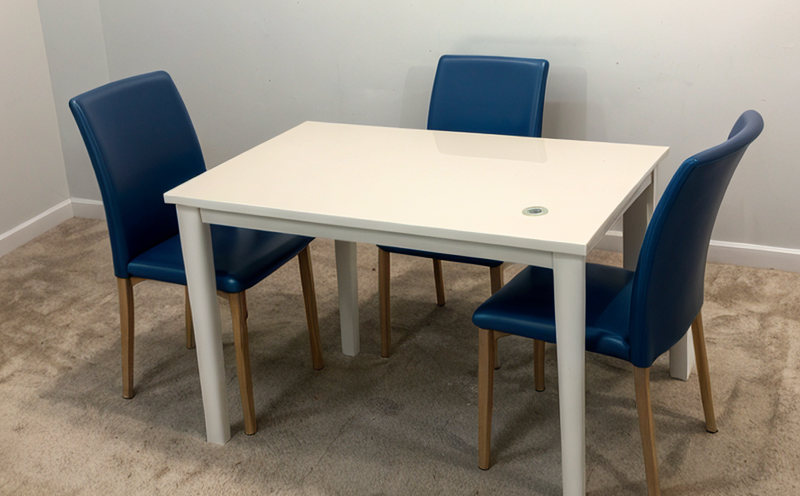ISO 899 Creep Testing of Interior Plastics
The ISO 899-1 standard provides a comprehensive method to determine the creep behavior of thermoplastics under defined load and temperature conditions. This service is essential for quality managers, compliance officers, R&D engineers, and procurement professionals working with furniture and interior plastics.
Creep testing is critical in ensuring that materials used in interior applications such as upholstery, flooring, and trim withstand the stresses imposed by prolonged use and environmental factors. Creep deformation can lead to material failure over time, which could compromise product safety and durability. This service helps manufacturers verify that their products meet regulatory standards and customer expectations.
The test involves applying a specified load to a specimen at a defined temperature for an extended period, typically 100 hours or more. The creep strain is measured as the displacement of the specimen over time under constant stress. The results provide insights into the long-term performance of materials in real-world conditions.
Understanding creep behavior allows manufacturers to select appropriate materials and design products that meet durability and safety requirements. For instance, the choice of plastic for an armchair cushion should not only withstand immediate load but also maintain its shape over years of use without significant deformation.
The test is particularly important in environments where temperature variations are common, such as homes or commercial buildings. Materials used in these applications must be able to retain their structural integrity and aesthetic appeal under fluctuating conditions. By conducting ISO 899 creep testing, manufacturers can ensure that their products perform reliably across various environmental conditions.
The process involves several steps: selecting the appropriate specimen size and shape, conditioning the material according to standard requirements, applying the load at a specified temperature, recording strain over time, and analyzing the data. The results are used to assess compliance with relevant standards and to guide design improvements.
Why It Matters
The durability and safety of furniture and interior products depend heavily on the materials used in their construction. Creep testing ensures that these materials can withstand prolonged use without deforming significantly, which is crucial for maintaining product integrity and customer satisfaction.
- Ensures compliance with international standards like ISO 899
- Aids in selecting appropriate materials for specific applications
- Guarantees consistent quality across production batches
- Reduces the risk of product failure due to environmental factors
- Supports design optimization based on real-world performance data
The importance of creep testing extends beyond mere compliance. It plays a pivotal role in enhancing brand reputation by delivering high-quality, reliable products that meet or exceed customer expectations. By investing in this service, manufacturers can differentiate themselves in the market and build long-term relationships with satisfied customers.
Scope and Methodology
The ISO 899-1 standard provides a framework for conducting creep tests on thermoplastics under defined conditions. The scope of this service includes testing various types of interior plastics used in furniture, including polypropylene (PP), polyethylene terephthalate (PET), and polystyrene (PS).
| Material | Description |
|---|---|
| Polypropylene (PP) | A tough, versatile thermoplastic known for its excellent chemical resistance. |
| Polyethylene Terephthalate (PET) | A durable, strong plastic often used in beverage bottles and packaging. |
| Polystyrene (PS) | A lightweight, rigid plastic commonly used for insulation and protective packaging. |
The methodology involves conditioning the specimens to a specific temperature and humidity level before applying a load. The test is conducted over an extended period, typically 100 hours or more, to observe the creep behavior under constant stress. Strain measurements are recorded at regular intervals.
| Temperature | Description |
|---|---|
| 65°C | A common temperature for testing interior plastics due to its relevance in real-world applications. |
| 70°C | Slightly higher than ambient, simulating a warm environment. |
The results of the test are analyzed to determine the creep strain and modulus. These parameters provide valuable insights into the long-term performance of materials under stress. Compliance with ISO 899 ensures that products meet the highest standards of quality and reliability, enhancing consumer trust and satisfaction.
Quality and Reliability Assurance
- Standardized Procedures: Strict adherence to ISO 899-1 ensures consistent testing results across different labs.
- Data Accuracy: Precision instruments are used to measure strain accurately, reducing the margin of error.
- Repeatable Tests: The methodology is designed to yield reproducible results, allowing for reliable comparisons between batches or models.
The quality and reliability assurance measures in place ensure that the test results are accurate and consistent. This trustworthiness is critical for manufacturers seeking to meet regulatory requirements and build a reputation for high-quality products.





